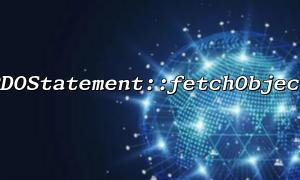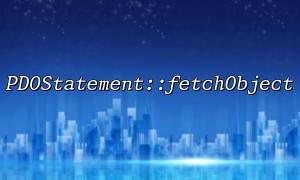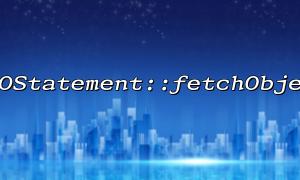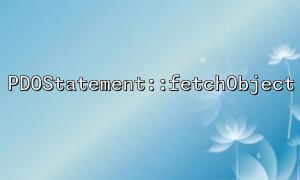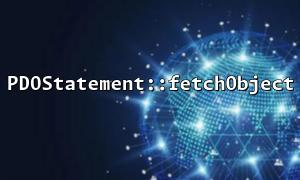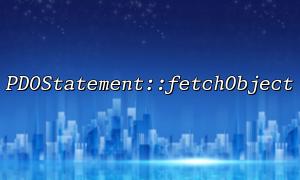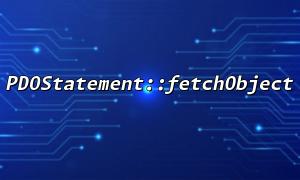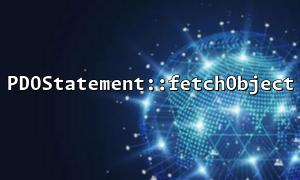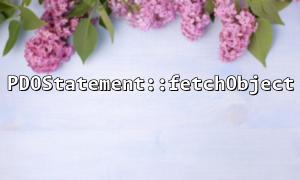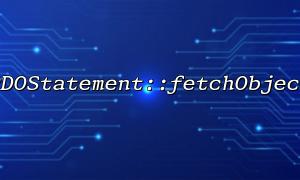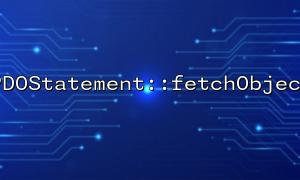In modern PHP application development, the ORM (Object Relational Mapping) framework has become an important bridge for database operations. It simplifies SQL writing and enhances the object-oriented experience of data operations. PDOStatement::fetchObject is a convenient method provided by PDO, which can directly map query results into PHP objects. Reasonably combining the two can greatly improve the performance of the data access layer and the maintainability of the code.
The fetchObject method allows developers to grab a row of data directly from the result set and encapsulate it into an object. The syntax is as follows:
public PDOStatement::fetchObject(string $class_name = "stdClass", array $constructor_args = []): object|false
class_name specifies the class name that needs to be instantiated.
constructor_args is used to pass an array of arguments to the class constructor.
If class_name is not specified, a stdClass object is returned by default.
Example:
$stmt = $pdo->query('SELECT id, name, email FROM users');
$user = $stmt->fetchObject();
echo $user->name;
In most ORM frameworks (such as Doctrine, Eloquent, Propel), object mapping is achieved through complex hydration mechanisms. Framework usually:
Get the query result array.
Iterate through the array and manually assign each column to the object's properties.
Supports association loading, lazy loading, etc.
Although it has rich features, this mapping method may be a bit cumbersome in simple scenarios, and the performance is not as efficient as using fetchObject directly.
In order to improve execution efficiency, we can directly use fetchObject in the ORM layer to quickly inject data into the corresponding entity object, rather than manually building the object every time.
Define the corresponding entity class for each database table.
Use PDO to query and call fetchObject to directly return the entity instance.
Manage it in conjunction with other ORM functions (such as saving, updating, deleting).
class User
{
public int $id;
public string $name;
public string $email;
public function getProfileUrl(): string
{
return 'https://gitbox.net/user/' . $this->id;
}
}
class UserRepository
{
private PDO $pdo;
public function __construct(PDO $pdo)
{
$this->pdo = $pdo;
}
public function find(int $id): ?User
{
$stmt = $this->pdo->prepare('SELECT * FROM users WHERE id = :id');
$stmt->execute(['id' => $id]);
$user = $stmt->fetchObject(User::class);
return $user ?: null;
}
}
$pdo = new PDO('mysql:host=localhost;dbname=testdb', 'root', '');
$repository = new UserRepository($pdo);
$user = $repository->find(1);
if ($user) {
echo $user->name . "'s profile: " . $user->getProfileUrl();
} else {
echo "User not found.";
}
In this example, the query data is directly mapped to the User class instance, and no additional assignment operation is required. The object method can be used immediately after query, such as obtaining the user profile page URL ( https://gitbox.net/user/1 ).
The field and attribute names must be consistent : fetchObject matches class attributes by column names by default.
Constructor parameter problem : If the entity class constructor has parameters, remember to pass it through the second parameter of fetchObject .
Data security : If external input is involved, preprocessing statements are still required to prevent SQL injection.
By combining fetchObject , we can easily achieve:
Batch pull collection of objects
Lazy object-based loading
Simple relationship binding (such as one-to-many association)
Further cooperate with strategies such as automatic generation of entity classes and batch operations, an efficient and lightweight ORM layer can be built without introducing a large ORM framework.
Related Tags:
PDOStatement